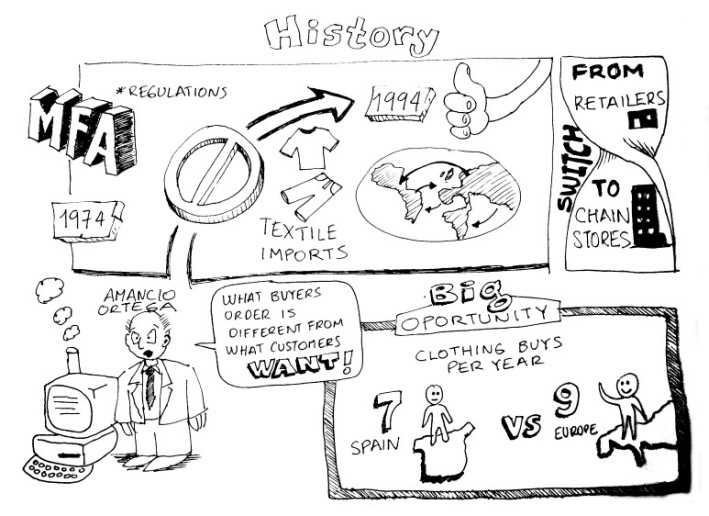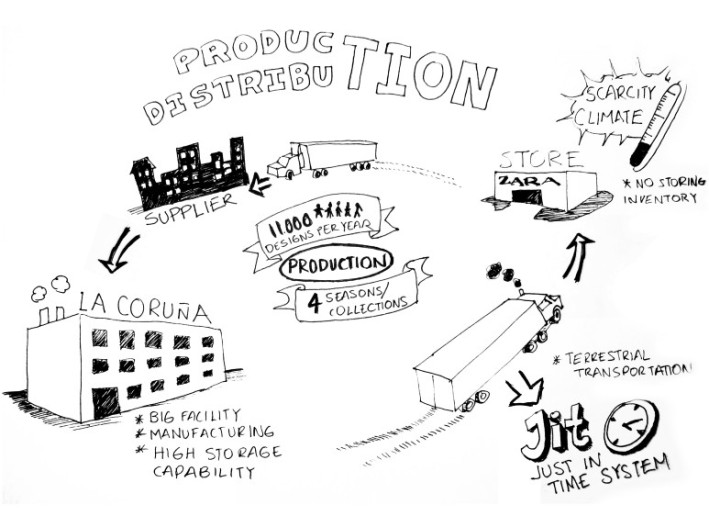This is an example of how sketching can help non-business professionals to clarify and comprehend a complex business case.
Had you ever heard about ZARA? If not, it can be briefly described as a Spanish clothing and accessories retailer furthermore it can be stated that it revolutionized forever the apparel industry in the decade of the 90s. Its disruptive and innovative business model has been subject of academic study in many times. The following visualizations are meant to quickly understand Zara’s success from five different aspects: history, competitors, design, production-distribution and internationalization.
History
In 1974 the Multi-Fiber Arrangement (MFA) regulated the global apparel trade, and also established restrictions to imports of textiles to some markets. Two decades later, this regulations changed and lead to a free and global textile trading market. Additionally, the apparel sales switch from little retailers and family ventures to chain stores. In 1975 Amancio Ortega, a Spaniard fashion entrepreneur founded Zara and eventually he was very concerned about how his clothing products could had filled his customers expectations through the use of information technologies and their feedback.
Competitors
Competitors did not have direct control in aspects as design, manufacturing, sales and advertising apparel. Zara designed, manufactured and sold its products and instead of investing in advertising, it focused in the generation of value for its customers. In an upcoming visualization, it shall be revealed what this value is.
Production-Distribution
As a consequence of understanding that fashion is very dynamic and customers often and quickly change their tastes related with clothing, Zara increased cycles of fashion by increasing them from the habitual two to four per year. In addition, it produced annually up to 300% more designs than its competitors. Consequently, Zara implemented a continuous and fast distribution process called “Just in time” which integrated the delivering of the apparel for its stores, the returning of leftovers to its manufacturing center and the picking up of supplies for the production into one circular route.
Design based on IT
The value that Zara wanted to generate to its customers was to provide them quickly with the newest fashion trends in an affordable price. In order to know which designs were successful in sales and which ones not, information technologies played an important role for the feeding of the future design process.
Internationalization
The consequent step that comes after a company is successful in its country is to expand abroad. Zara used an adaptable model with three variants to enter into a new country, nevertheless it was very careful taking the first step. It used to open only one store in order to gather information about the local culture, customer likes, trends, etc. to make a deep analysis. Once Zara, based on the research, had the certainty of obtaining success, it expanded in the new market multiplying its stores, and hence colonized a new country.
All in all, Zara’s initiatives in changing the conventional apparel commercialization, its internal structure, logistics, generation of value for customers and expansion strategy led it to be recognized not only by its economic success but as an example in leadership in the market and as a promoter of innovation ass well.







The write up is specifically thrilling and well informing i must say. i love the graphical illustrations can i borrow it for my masters dissertation? secondly i am examining the business model, can i get sources from you? thanks very much. chuma
Thanks for asking, it is ok, you can use it. Cheers!